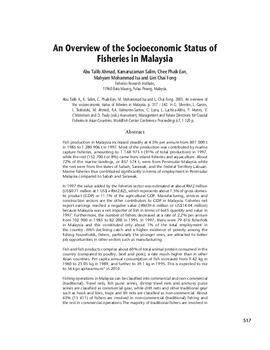An overview of the socioeconomic status of fisheries in Malaysia

Citation
Ahmad, A.T. et al. (2003). An overview of the socioeconomic status of fisheries in Malaysia. p. 517-542. Assessment, management and future directions for coastal fisheries in Asian countries. WorldFish Center conference proceedings; 67
Fish production in Malaysia increased steadily at 4.5% per annum from 801 000 t in 1985 to 1 280 906 t in 1997. Most of the production was contributed by marine capture fisheries, amounting to 1 168 973 t (91% of total production) in 1997, while the rest (132 700 t or 8%) came from inland fisheries and aquaculture. About 72% of the marine landings, or 837 574 t, were from Peninsular Malaysia while the rest were from the states of Sabah, Sarawak, and the Federal Territory Labuan. Marine fisheries thus contributed significantly in terms of employment in Peninsular Malaysia compared to Sabah and Sarawak. In 1997 the value added by the fisheries sector was estimated at about RM2 million (US$0.71 million at 1 US$ = RM2.82), which represents about 1.5% of gross domestic product (GDP) or 11.1% of the agricultural GDP. Manufacturing, services and construction sectors are the other contributors to GDP in Malaysia. Fisheries net export earnings reached a negative value (-RM39.6 million or US$14.04 million) because Malaysia was a net importer of fish in terms of both quantity and value in 1997. Furthermore, the number of fishers decreased at a rate of 2.2% per annum from 102 900 in 1985 to 82 200 in 1995. In 1997, there were 79 616 fisherfolk in Malaysia and this constituted only about 1% of the total employment in the country. With declining catch and a higher incidence of poverty among the fishing households, fishers, particularly the younger ones, are attracted to better job opportunities in other sectors such as manufacturing. Fish and fish products comprise about 60% of total animal protein consumed in the country (compared to poultry, beef and pork), a rate much higher than in other Asian countries. Per capita annual consumption of fish increased from 9.42 kg in 1960 to 23.05 kg in 1989, and further to 39.1 kg in 1995. This is expected to rise to 56 kg·capita·annum-1 in 2010. Fishing operations in Malaysia can be classified into commercial and non-commercial (traditional). Trawl nets, fish purse seines, shrimp trawl nets and anchovy purse seines are classified as commercial gear, while drift nets and other traditional gear such as hook and lines, traps and lift nets are classified as non-commercial. About 63% (15 611) of fishers are involved in non-commercial (traditional) fishing and the rest in commercial operations.The majority of traditional fishers are involved in other economic activities such as farming, contract work, retailing and tourism. Due to limited fisheries resources, the number of registered fishing vessels decreased from 22 026 units in 1980 to 14 211 units in 1997 on the West Coast of Peninsular Malaysia. Commercial fishing vessels are generally larger than 25 GRT (gross registered tonnage) with engine capacities up to 180 HP, while traditional fishing vessels are generally less than 15 GRT with engine capacities less than 18 HP. Normally commercial fishing boats use modern navigational aids like Geographic Positioning Systems (GPS) and are fitted with Refrigerated Sea Water (RSW). The capital investment for a trawler and purse seiner of 25 - 69.9 GRT was RM100 000 in 1989, including the boat hull, engine, gearbox, net and accessory equipment. Annual net profit derived from a 25 - 39.9 GRT trawler in 1989 was RM36 520, while that from a 40 - 69.9 GRT trawler was RM43 601. For the fish purse seine, 25 - 39.9 GRT and 40 - 69.9 GRT vessels made net profits of RM40 102 and RM63 562 respectively. In terms of productivity efficiency, the larger vessels, trawl and purse seine (40 - 69.9 GRT) are more efficient than the smaller fleet (25 - 39.9 GRT). Labor productivity for large trawls is 219 kg per person-day compared to the smaller trawl of only 129 kg·person-day-1. For the purse seine fishery, large vessel labor productivity is 69 kg·person-day-1 and for the smaller vessel only 53 kg·person-day-1. The government has decided to reduce the number of trawl vessels especially those operating in inshore areas, and to encourage fishers to explore new areas in the offshore waters. In order to conserve fishery resources, the government has tried to provide incentives through tax deductions for ‘pioneer status’, investment tax allowances, tax exemptions for imports and a sales tax on fishing machinery, raw materials and equipment.
Permalink
Date Available
Type
Publisher
Countries
Copyright
CC BY 4.0
Research Themes
Topics
Language